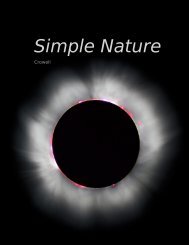The size of a radio antenna is closely related to ... - Light and Matter
The size of a radio antenna is closely related to ... - Light and Matter
The size of a radio antenna is closely related to ... - Light and Matter
Create successful ePaper yourself
Turn your PDF publications into a flip-book with our unique Google optimized e-Paper software.
can be constructed as a superposition <strong>of</strong> sine waves with frequencies<br />
f, 2f, 3f, . . . In th<strong>is</strong> sense, sine waves are the basic, pure building<br />
blocks <strong>of</strong> all waves. (Fourier’s result so surpr<strong>is</strong>ed the mathematical<br />
community <strong>of</strong> France that he was ridiculed the first time he publicly<br />
presented h<strong>is</strong> theorem.)<br />
However, what definition <strong>to</strong> use <strong>is</strong> really a matter <strong>of</strong> convenience.<br />
Our sense <strong>of</strong> hearing perceives any two sounds having the same<br />
period as possessing the same pitch, regardless <strong>of</strong> whether they are<br />
sine waves or not. Th<strong>is</strong> <strong>is</strong> undoubtedly because our ear-brain system<br />
evolved <strong>to</strong> be able <strong>to</strong> interpret human speech <strong>and</strong> animal no<strong>is</strong>es,<br />
which are periodic but not sinusoidal. Our eyes, on the other h<strong>and</strong>,<br />
judge a color as pure (belonging <strong>to</strong> the rainbow set <strong>of</strong> colors) only<br />
if it <strong>is</strong> a sine wave.<br />
D<strong>is</strong>cussion Questions<br />
A Suppose we superimpose two sine waves with equal amplitudes<br />
but slightly different frequencies, as shown in the figure. What will the<br />
superposition look like? What would th<strong>is</strong> sound like if they were sound<br />
waves?<br />
v / D<strong>is</strong>cussion question A.<br />
w / <strong>The</strong> pattern <strong>of</strong> waves made<br />
by a point source moving <strong>to</strong> the<br />
right across the water. Note<br />
the shorter wavelength <strong>of</strong> the<br />
forward-emitted waves <strong>and</strong><br />
the longer wavelength <strong>of</strong> the<br />
backward-going ones.<br />
6.1.5 <strong>The</strong> Doppler effect<br />
Figure 7.2.8 shows the wave pattern made by the tip <strong>of</strong> a vibrating<br />
rod which <strong>is</strong> moving across the water. If the rod had been<br />
vibrating in one place, we would have seen the familiar pattern <strong>of</strong><br />
concentric circles, all centered on the same point. But since the<br />
source <strong>of</strong> the waves <strong>is</strong> moving, the wavelength <strong>is</strong> shortened on one<br />
side <strong>and</strong> lengthened on the other. Th<strong>is</strong> <strong>is</strong> known as the Doppler<br />
effect.<br />
Note that the velocity <strong>of</strong> the waves <strong>is</strong> a fixed property <strong>of</strong> the<br />
medium, so for example the forward-going waves do not get an extra<br />
boost in speed as would a material object like a bullet being shot<br />
forward from an airplane.<br />
We can also infer a change in frequency. Since the velocity <strong>is</strong><br />
constant, the equation v = fλ tells us that the change in wavelength<br />
must be matched by an opposite change in frequency: higher<br />
frequency for the waves emitted forward, <strong>and</strong> lower for the ones<br />
emitted backward. <strong>The</strong> frequency Doppler effect <strong>is</strong> the reason for<br />
354 Chapter 6 Waves














